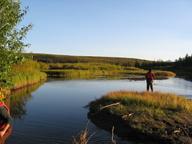The most recent literature concerning the aquatic benthic macroinvertebrate community of the Kobuk River suggests that the general abundance and diversity of insects are low, due largely impart to extremely harsh and long winters and the subsequent short growing season. Recent data collection on the mainstem of the Kobuk River appears to support this notion; however, side channel and tributary productivity and diversity greatly exceed that of the mainstem Kobuk. This suggests that side channels and tributaries play an important role in supporting higher trophic pathways in an otherwise depauperate system. Due to the relative increases in abundance and diversity of benthic macroinvertebrates in side channel and tributary habitats, it’s likely that these areas could 1) provide secondary production subsidies to the main stem of the Kobuk and 2) serve as important rearing habitats for juvenile fish such as the Arctic Grayling.

Macroinvertebrate data were collected at 14 different sites over a period of nine days, using a kicknet. Invertebrates from each sample were sorted, identified (to family where possible) and counted in the field. Three distinct habitats were sampled including the mainstem of the Kobuk River, its side channels, and local tributaries feeding the Kobuk River. Mainstem locations were defined as those occurring on the main branch of the Kobuk. Side channels were characterized as non-mainstem branches of the Kobuk River which generally showed a slower residence time of water. Finally, tributaries were sampled throughout the watershed near their confluence with the mainstem Kobuk River. Data collected from side channel habitats showed the greatest mean abundance (Figure 1), total richness (Figure 2), and EPT (Ephemeroptera Plecoptera Trichoptera) richness (Figure 3) of benthic invertebrates of all habitats sampled. In addition, sampled tributaries, on average, showed higher abundances, total richness, and EPT richness relative to the mainstem of the Kobuk River.
Secondary production discrepancies between side channels, tributaries, and mainstem habitats occur for several reasons. Side channel habitats, and to some extent tributaries, appear to show higher levels of primary productivity (filamentous algae, periphyton, macrophytes, etc.), which is likely a function of a shallower photic zone, more open canopy, and a slower (higher) residence time of water. Increased primary productivity benefits aquatic macroinvertebrates by providing a direct net resource benefit, additional habitat colonization space, and refuge from predators. Most importantly, however, is the residence time of water. Flow pulses during spring runoff and August rain events likely entrain mainstem bed sediments, whereas side channel and tributary habitats in comparison remain somewhat immobile (from less intense runoff), thus allowing primary producers to colonize at a more rapid pace.

